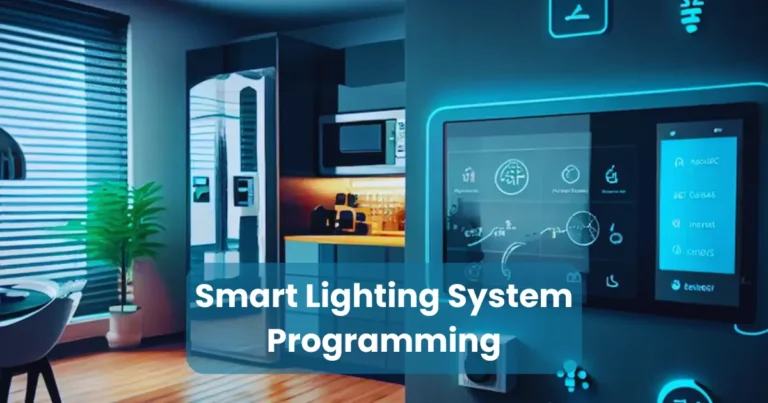Home Automation Lighting Languages: A Complete Guide

Contents
- 1 What Are Home Automation Lighting Languages?
- 2 Importance of Home Automation Lighting Languages
- 3 Types of Home Automation Lighting Languages
- 4 How Home Automation Lighting Languages Work
- 5 Choosing the Right Home Automation Lighting Language
- 6 Benefits of Using Home Automation Lighting Languages
- 7 Common Challenges and Solutions in Home Automation Lighting Languages
- 8 Future of Home Automation Lighting Languages
- 8.1 1. Rise of Matter as a Universal Standard
- 8.2 2. AI-Driven Smart Lighting Automation
- 8.3 3. Expansion of IoT and Edge Computing
- 8.4 4. Energy-Efficient and Sustainable Smart Lighting
- 8.5 5. Integration with 5G and Faster Wireless Communication
- 8.6 6. Advanced Security and Privacy Measures
- 8.7 7. Holographic and Augmented Reality (AR) Smart Lighting Control
- 8.8 Conclusion
Home automation lighting languages have revolutionized the way smart homes function. These protocols enable seamless communication between smart lighting devices, allowing users to control brightness, color, and scheduling with ease. Without these languages, integrating different smart lighting brands would be challenging, leading to compatibility issues. As smart home adoption continues to grow, understanding home automation lighting languages becomes essential for homeowners, developers, and tech enthusiasts. This article explores the different lighting protocols, their importance, and how to choose the right one for your home.
What Are Home Automation Lighting Languages?
Home automation lighting languages are communication protocols that enable smart lighting systems to interact with each other and with central controllers. These languages define how devices send and receive data, ensuring seamless operation within a smart home network.
Smart lighting protocols play a crucial role in maintaining interoperability between different brands and technologies. Without a standardized communication method, integrating smart bulbs, switches, and sensors would be difficult. These languages allow homeowners to control lighting remotely, automate schedules, and optimize energy efficiency.
Various home automation lighting languages exist, each with its own advantages and compatibility features. Some protocols prioritize low power consumption, while others focus on faster data transfer and wider coverage. Selecting the right lighting language depends on factors such as device compatibility, network range, and security.
Importance of Home Automation Lighting Languages
Home automation lighting languages play a crucial role in creating a seamless and efficient smart lighting system. These protocols ensure that different devices communicate effectively, enhancing user experience and convenience. Here’s why they are essential:

1. Interoperability Between Devices
Smart lighting brands use different technologies, but home automation lighting languages enable them to work together. A standardized protocol allows light bulbs, dimmers, motion sensors, and switches from different manufacturers to communicate without compatibility issues.
2. Remote Control and Automation
With the right lighting language, users can control their smart lights remotely via mobile apps, voice assistants, or central hubs. Scheduling and automation features help optimize lighting settings based on time, occupancy, or environmental conditions.
3. Energy Efficiency
Smart lighting systems reduce energy consumption by adjusting brightness levels, turning off unused lights, and integrating with motion sensors. Home automation lighting languages facilitate these energy-saving features by ensuring fast and reliable communication between devices.
4. Enhanced Security
Secure communication protocols protect smart lighting systems from hacking and unauthorized access. Encryption and authentication features prevent cyber threats, ensuring that lighting controls remain safe from external interference.
5. Scalability and Future-Proofing
A well-established lighting protocol makes it easier to expand a smart home setup. Users can add new smart lights, sensors, or automation features without worrying about compatibility issues. Future advancements in lighting technology can also be integrated more seamlessly with standardized protocols.
6. Improved User Experience
By ensuring smooth communication between lighting devices, home automation lighting languages provide a more intuitive and responsive user experience. Lights respond quickly to commands, automation works reliably, and troubleshooting becomes easier with a well-defined protocol.
In summary, home automation lighting languages are essential for a connected, efficient, and secure smart lighting ecosystem. Choosing the right protocol enhances interoperability, convenience, and energy savings, making smart lighting a valuable addition to any modern home.
Types of Home Automation Lighting Languages
Various home automation lighting languages enable smart lighting systems to communicate effectively. Each protocol offers unique features, including power efficiency, range, and compatibility. Below are the most commonly used lighting languages in home automation:

1. Zigbee
Zigbee is a low-power, wireless communication protocol widely used in smart home lighting. It operates on the 2.4 GHz frequency and supports mesh networking, allowing devices to relay signals to one another. This feature extends the network range and ensures reliable communication, even if one device fails. Zigbee is known for its low energy consumption, making it ideal for battery-powered smart lighting devices.
2. Z-Wave
Z-Wave is another popular wireless protocol designed specifically for smart home applications. Operating on a lower frequency (908 MHz in North America and 868 MHz in Europe), Z-Wave experiences minimal interference from Wi-Fi networks. Like Zigbee, it supports mesh networking, improving signal range and reliability. Z-Wave ensures strong security with AES-128 encryption, making it a safe choice for smart lighting automation.
3. Bluetooth Mesh
Bluetooth Mesh extends the capabilities of traditional Bluetooth by allowing multiple devices to form a decentralized network. Unlike standard Bluetooth, which requires direct device-to-device communication, Bluetooth Mesh enables messages to hop between devices, improving range and coverage. This protocol is commonly used in smart bulbs and lighting fixtures, allowing users to control lights directly from their smartphones without requiring a hub.
4. Wi-Fi-Based Protocols
Many smart lighting systems use Wi-Fi to connect directly to a home network. This method provides high-speed communication, eliminating the need for additional hubs or bridges. However, Wi-Fi-based smart lighting consumes more power compared to Zigbee and Z-Wave, making it less suitable for battery-operated devices. Wi-Fi lighting systems are ideal for users who want simple, hub-free smart lighting solutions with remote access through mobile apps.
5. Thread
Thread is an emerging home automation lighting language designed to provide secure, low-power, and scalable communication for smart home devices. Unlike Zigbee and Z-Wave, Thread is based on Internet Protocol (IP), allowing direct communication with other internet-connected devices. It also supports mesh networking, ensuring reliable performance even in large smart home setups. With growing adoption in the Matter smart home standard, Thread is becoming a future-proof choice for smart lighting automation.
Comparison of Home Automation Lighting Languages
| Protocol | Frequency | Power Consumption | Network Type | Security | Hub Required? |
| Zigbee | 2.4 GHz | Low | Mesh | High | Yes |
| Z-Wave | 908/868 MHz | Low | Mesh | Very High | Yes |
| Bluetooth Mesh | 2.4 GHz | Medium | Mesh | High | No (Phone acts as controller) |
| Wi-Fi | 2.4/5 GHz | High | Star | Moderate | No |
| Thread | 2.4 GHz | Low | Mesh | Very High | No (If Matter-enabled) |
Each lighting language has its strengths and limitations. Choosing the right one depends on factors such as network stability, energy efficiency, and compatibility with existing smart home devices.
How Home Automation Lighting Languages Work
Home automation lighting languages function as communication protocols that allow smart lighting devices to interact seamlessly. These languages define how commands are transmitted, received, and executed within a smart home network. Understanding their working mechanism helps in choosing the right protocol for an efficient lighting system.

1. Establishing Communication
Smart lighting devices connect to a home automation system using one of the supported lighting languages, such as Zigbee, Z-Wave, Bluetooth Mesh, Wi-Fi, or Thread. The communication process involves three key components:
- Controller/Gateway: Acts as the central hub, sending and receiving commands.
- Smart Lighting Devices: Includes smart bulbs, switches, and dimmers that respond to commands.
- Network Protocol: Determines how signals are transmitted between devices.
2. Sending and Receiving Signals
When a user issues a command (e.g., turning on the lights via a mobile app or voice assistant), the request travels through the selected home automation lighting language:
- Zigbee and Z-Wave: Use a mesh network where devices relay signals to extend coverage and ensure reliability.
- Bluetooth Mesh: Allows direct communication between lighting devices without requiring a central hub.
- Wi-Fi: Connects smart lights directly to a router, enabling remote control via cloud-based applications.
- Thread: Uses an IP-based mesh network, ensuring fast and secure device communication.
3. Processing Commands and Automation
Once the signal reaches the smart lighting device, the command is processed based on pre-set conditions. Automation features allow lights to function without manual input by integrating with sensors and schedules:
- Motion Sensors: Lights turn on automatically when movement is detected.
- Time-Based Automation: Smart lights adjust brightness at specific times.
- Voice Control: Users issue commands via smart assistants like Alexa, Google Assistant, or Siri.
4. Data Encryption and Security
To protect smart lighting systems from unauthorized access, home automation lighting languages incorporate encryption and authentication mechanisms:
- Z-Wave and Zigbee: Use AES-128 encryption for secure data transmission.
- Thread: Provides high-level security with built-in encryption and firewall protection.
- Wi-Fi-Based Systems: Rely on network security protocols like WPA3 to prevent hacking attempts.
5. Response and Feedback Mechanism
After executing a command, smart lights send feedback to the controller. For example, when a user dims a light via an app, the system confirms the change in real time. This feedback loop ensures reliability and enhances user experience.
Home automation lighting languages work by facilitating seamless communication between smart lighting devices and controllers. Whether using Zigbee, Z-Wave, Bluetooth Mesh, Wi-Fi, or Thread, these protocols ensure fast, secure, and efficient lighting automation. Choosing the right language depends on factors like device compatibility, network stability, and security requirements.
Choosing the Right Home Automation Lighting Language
Selecting the best home automation lighting language depends on several factors, including compatibility, network reliability, security, and power efficiency. Understanding these aspects helps in making an informed decision that aligns with your smart home needs.

1. Compatibility with Existing Smart Home Devices
Before choosing a lighting protocol, check its compatibility with your existing smart home ecosystem. Some protocols work seamlessly with certain brands or ecosystems:
- Zigbee & Z-Wave: Work well with hubs like SmartThings, Amazon Echo Plus, and Hubitat.
- Wi-Fi: Compatible with standalone devices that connect directly to a router, such as TP-Link Kasa or LIFX bulbs.
- Thread: Best suited for Matter-enabled devices, ensuring future-proof integration.
2. Network Reliability & Range
The range and stability of the connection play a vital role in determining the right home automation lighting language:
- Zigbee & Z-Wave: Use mesh networking, making them ideal for large homes since devices extend the signal.
- Wi-Fi: Offers strong connectivity but may slow down with too many connected devices.
- Bluetooth Mesh: Works well for close-range lighting setups but has limited reach.
3. Power Consumption
Smart lighting systems, especially those with battery-powered components, require efficient protocols:
- Zigbee & Z-Wave: Designed for low-power consumption, ideal for sensors and wireless switches.
- Wi-Fi: Consumes more energy, making it less suitable for battery-operated devices.
- Thread: Optimized for energy efficiency while providing fast and secure communication.
4. Security & Privacy
Cybersecurity is a crucial factor when selecting a smart lighting protocol:
- Z-Wave & Zigbee: Offer strong AES-128 encryption for secure data transmission.
- Wi-Fi: Security depends on router encryption settings (WPA3 recommended).
- Thread: Provides built-in encryption and security mechanisms for enhanced protection.
5. Ease of Installation & Setup
Some lighting languages require additional hubs, while others work without extra hardware:
- Wi-Fi & Bluetooth Mesh: Do not require a hub, making them easier to set up.
- Zigbee & Z-Wave: Require a compatible hub but offer better scalability.
- Thread: Works best with Matter-supported devices and does not require a dedicated hub.
6. Future Scalability & Integration
If you plan to expand your smart home, choose a protocol that supports scalability:
- Zigbee & Z-Wave: Excellent for large networks with multiple devices.
- Thread: Future-proof with Matter integration, allowing seamless device compatibility.
- Wi-Fi: Limited scalability due to network congestion with multiple devices.
Comparison Table for Choosing the Right Lighting Language
| Factor | Zigbee | Z-Wave | Bluetooth Mesh | Wi-Fi | Thread |
| Compatibility | High | High | Medium | High | Very High |
| Network Range | Medium | High | Low | High | Medium |
| Power Efficiency | High | High | Medium | Low | High |
| Security | High | Very High | Medium | Medium | Very High |
| Hub Required? | Yes | Yes | No | No | No (if Matter-enabled) |
| Scalability | High | High | Medium | Low | Very High |
The best home automation lighting language depends on your specific needs:
- For extensive smart home networks → Choose Zigbee or Z-Wave for mesh networking and scalability.
- For a hub-free setup → Use Wi-Fi or Bluetooth Mesh for simplicity and direct device control.
- For future-proof integration → Opt for Thread, especially if using Matter-compatible devices.
By evaluating these factors, you can select the most efficient, secure, and scalable home automation lighting language for your smart home setup.
Benefits of Using Home Automation Lighting Languages
Integrating home automation lighting languages into a smart home system provides numerous advantages, including convenience, energy efficiency, security, and seamless control. These protocols enable smart lights to communicate effectively, ensuring a reliable and intelligent lighting experience.

1. Seamless Smart Home Integration
Home automation lighting languages allow smart lighting systems to integrate smoothly with other smart home devices, creating a unified ecosystem. This enhances automation, enabling lights to sync with security systems, thermostats, and voice assistants like:
- Amazon Alexa
- Google Assistant
- Apple HomeKit
For example, when a smart door lock is engaged, the lights can automatically turn off, ensuring energy savings.
2. Enhanced Energy Efficiency
Smart lighting protocols optimize energy consumption by enabling:
- Adaptive brightness adjustments based on ambient light.
- Scheduled automation to turn lights off when not needed.
- Motion-sensor integration to illuminate spaces only when occupied.
Protocols like Zigbee and Z-Wave support low-power communication, making them ideal for reducing electricity usage without compromising performance.
3. Remote and Voice-Controlled Convenience
Using home automation lighting languages, smart lights can be controlled remotely via mobile apps or voice assistants. This provides:
- Hands-free operation for enhanced accessibility.
- Remote access to turn lights on/off while away from home.
- Multi-device synchronization to control multiple lights simultaneously.
Wi-Fi-based lighting systems allow direct cloud access, while Zigbee, Z-Wave, and Thread provide local control, ensuring reliability even during internet outages.
4. Increased Security and Safety
Smart lighting languages enhance home security through automated lighting schedules and real-time control. Key security benefits include:
- Simulated occupancy: Lights turn on and off randomly when no one is home, deterring intruders.
- Integration with security systems: Motion-activated lights illuminate entryways when suspicious movement is detected.
- Encrypted communication: Protocols like Zigbee, Z-Wave, and Thread use AES encryption to prevent hacking attempts.
5. Scalability and Future-Proofing
Choosing the right home automation lighting language ensures long-term scalability and future compatibility.
- Zigbee and Z-Wave support large-scale smart lighting networks through mesh technology.
- Thread is future-proof due to Matter integration, ensuring compatibility with upcoming smart home devices.
- Bluetooth Mesh and Wi-Fi offer plug-and-play solutions for quick, small-scale implementations.
This flexibility allows homeowners to expand their smart lighting setup without replacing existing devices.
6. Customizable Automation and Scene Control
Smart lighting protocols enable users to create personalized lighting scenes and automation sequences:
- Wake-up routines: Gradually increase brightness in the morning.
- Relaxation modes: Adjust color temperature and brightness for a cozy ambiance.
- Theater settings: Sync lights with entertainment systems for an immersive experience.
With lighting languages like Zigbee and Z-Wave, homeowners can automate these settings through dedicated apps or smart hubs.
Using home automation lighting languages provides greater control, efficiency, security, and customization. Whether optimizing energy consumption, enhancing security, or ensuring seamless integration with smart devices, these protocols make modern homes more intelligent and convenient. Selecting the right lighting language ensures long-term reliability and adaptability to future smart home innovations.
Common Challenges and Solutions in Home Automation Lighting Languages
While home automation lighting languages offer numerous benefits, they also come with certain challenges. These issues range from compatibility problems to security risks and network interference. However, each challenge has practical solutions to ensure a seamless smart lighting experience.
1. Compatibility Issues
Challenge: Some smart lights and devices use different home automation lighting languages, making integration difficult. For example, a Zigbee-based light may not work with a Wi-Fi-only smart hub.
Solution:
- Choose universal smart hubs like SmartThings, Hubitat, or Home Assistant, which support multiple protocols.
- Opt for Matter-compatible devices that work across Zigbee, Thread, and Wi-Fi.
- Use protocol bridges, such as Philips Hue Bridge, to connect Zigbee lights with non-Zigbee ecosystems.
2. Network Interference and Connectivity Problems
Challenge: Too many wireless devices can cause network congestion, leading to slow or unreliable smart lighting responses. Zigbee and Wi-Fi operate on the 2.4 GHz band, increasing the risk of interference.
Solution:
- Use dedicated smart home hubs for Zigbee and Z-Wave devices to reduce Wi-Fi congestion.
- Switch Wi-Fi networks to the 5 GHz band for non-smart home devices.
- Strategically place repeaters or mesh extenders to improve signal strength for Zigbee and Z-Wave networks.
3. Latency and Slow Response Time
Challenge: Delayed responses when turning lights on/off can be frustrating. This may occur due to cloud dependency or weak network signals.
Solution:
- Use local processing hubs (e.g., Hubitat) instead of cloud-based controls to reduce lag.
- Ensure that Zigbee or Z-Wave mesh networks have sufficient connected devices for better responsiveness.
- Keep firmware and app updates current to optimize device performance.
4. Security Risks and Hacking Concerns
Challenge: Smart home networks, especially Wi-Fi-connected devices, can be vulnerable to cyber threats. Weak encryption or unprotected devices may expose the system to unauthorized access.
Solution:
- Choose protocols with AES encryption, such as Zigbee, Z-Wave, or Thread.
- Use strong Wi-Fi passwords and enable WPA3 encryption on your router.
- Regularly update firmware and avoid connecting smart home devices to public or unsecured networks.
5. Power Consumption and Battery Drain
Challenge: Battery-powered smart switches and motion sensors may drain quickly, especially in high-traffic areas. Wi-Fi-based devices also consume more energy than Zigbee or Z-Wave devices.
Solution:
- Use low-power protocols like Zigbee, Z-Wave, or Thread for battery-operated devices.
- Adjust motion sensor timeout settings to reduce unnecessary activations.
- Opt for wired smart lighting solutions whenever possible to eliminate battery dependency.
6. Limited Device Range in Large Homes
Challenge: Smart lighting systems may struggle with coverage in large houses, leading to unresponsive devices in distant rooms.
Solution:
- Use Zigbee or Z-Wave mesh networks, where each device extends the range.
- Install signal repeaters or additional hubs to strengthen connectivity.
- Ensure smart bulbs and switches are strategically placed to maintain an uninterrupted network.
7. Difficult Setup and Configuration
Challenge: Setting up different home automation lighting languages can be complex, requiring multiple apps or hubs.
Solution:
- Choose user-friendly platforms like Google Home, Amazon Alexa, or Apple HomeKit for simplified device pairing.
- Use Matter-supported devices to ensure seamless cross-platform integration.
- Follow manufacturer guidelines and tutorials for hassle-free setup.
While challenges exist in using home automation lighting languages, these issues can be resolved with proper planning, the right technology, and best practices. By ensuring device compatibility, optimizing network settings, and prioritizing security, homeowners can enjoy a reliable and efficient smart lighting system.
Future of Home Automation Lighting Languages
The evolution of home automation lighting languages is shaping a future where smart lighting becomes more intelligent, interoperable, and energy-efficient. With advancements in artificial intelligence, connectivity standards, and sustainability, the next generation of smart lighting protocols will offer enhanced functionality and seamless integration with other smart home devices.

1. Rise of Matter as a Universal Standard
One of the biggest transformations in home automation lighting languages is the adoption of Matter, a new industry-standard protocol supported by major tech companies, including Apple, Google, Amazon, and Samsung.
- Interoperability: Matter aims to unify Zigbee, Thread, Wi-Fi, and Bluetooth devices, reducing compatibility issues.
- Local Processing: Unlike cloud-dependent systems, Matter prioritizes local device communication, ensuring faster response times and greater reliability.
- Enhanced Security: Built-in encryption and authentication mechanisms will make smart lighting networks more secure.
As Matter gains wider adoption, future smart lighting setups will become easier to configure and integrate with various ecosystems.
2. AI-Driven Smart Lighting Automation
Artificial intelligence is expected to play a major role in the future of home automation lighting languages. AI-powered lighting systems will be able to:
- Predict user behavior and adjust lighting preferences automatically.
- Optimize energy efficiency by learning daily routines and adjusting brightness levels accordingly.
- Enhance personalization with dynamic scene adjustments based on time of day, weather, and mood detection.
With AI advancements, smart lighting will become more intuitive, offering truly hands-free automation.
3. Expansion of IoT and Edge Computing
The Internet of Things (IoT) and edge computing will further enhance smart lighting capabilities.
- Faster processing: Edge computing will enable real-time adjustments without relying on cloud servers.
- Improved reliability: Devices will continue to function even if the internet is down.
- Increased scalability: IoT expansion will allow seamless integration with more smart home gadgets, from security systems to HVAC controls.
4. Energy-Efficient and Sustainable Smart Lighting
Future home automation lighting languages will focus on sustainability through:
- Ultra-low-power protocols like Thread and Zigbee for minimal energy consumption.
- Solar-powered and kinetic-energy-based smart lighting to reduce dependency on electrical grids.
- Adaptive lighting technology that adjusts brightness based on natural light availability, reducing unnecessary power usage.
As governments push for greener technologies, smart lighting protocols will evolve to meet energy efficiency standards.
5. Integration with 5G and Faster Wireless Communication
The introduction of 5G networks will revolutionize home automation lighting by:
- Reducing latency for instant responses in smart lighting control.
- Supporting larger networks with increased bandwidth, allowing more devices to connect seamlessly.
- Enabling remote automation with near-zero delays, making smart lighting more reliable from any location.
6. Advanced Security and Privacy Measures
As cyber threats continue to rise, future home automation lighting languages will incorporate stronger security features:
- End-to-end encryption to prevent unauthorized access.
- Decentralized authentication methods using blockchain technology.
- Advanced biometric access controls, such as voice recognition and facial authentication, for personalized lighting control.
7. Holographic and Augmented Reality (AR) Smart Lighting Control
Innovations in AR and holographic interfaces will allow homeowners to:
- Control lighting through AR glasses or smart mirrors.
- Use virtual assistants with 3D holographic displays to adjust lighting settings intuitively.
- Create immersive home experiences, where lighting dynamically adapts to AR environments for gaming, entertainment, and workspaces.
The future of home automation lighting languages promises a more connected, intelligent, and sustainable ecosystem. With Matter, AI-driven automation, IoT advancements, and stronger security, smart lighting will become more seamless and user-friendly. As technology evolves, homeowners can expect a smarter, more intuitive, and energy-efficient lighting experience.
Conclusion
Home automation lighting languages are revolutionizing how homeowners control and optimize their lighting systems. These protocols enable seamless communication between smart bulbs, switches, hubs, and voice assistants, creating a more efficient and personalized lighting experience.
As technology advances, Matter is emerging as a unifying standard, eliminating compatibility issues and simplifying integration across different ecosystems. Meanwhile, artificial intelligence and IoT-driven automation are enhancing the responsiveness and adaptability of smart lighting systems. Additionally, with growing concerns about energy efficiency, newer protocols are focusing on sustainability through low-power consumption and adaptive lighting technologies.
Despite challenges like compatibility issues, network interference, and security concerns, practical solutions such as universal hubs, mesh networks, and encryption technologies ensure a reliable and secure smart lighting setup.
Looking ahead, the future of home automation lighting languages is promising, with AI-driven automation, 5G connectivity, and augmented reality interfaces set to redefine the way we interact with lighting. By embracing these innovations, homeowners can enjoy a smarter, safer, and more energy-efficient lighting environment.






